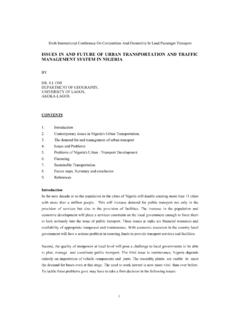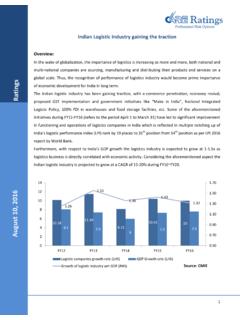Transcription of Nepad Policy Focus Series - OECD
1 The South African Institute of International Affairs Nepad Policy Focus Series Working Together Assessing Public Private Partnerships in Africa Peter Farlam SAIIA s Nepad and Governance Project is funded by the Royal Netherlands Embassy, Pretoria. Copyright SAIIA, February 2005 All rights reserved THE SOUTH AFRICAN INSTITUTE OF INTERNATIONAL AFFAIRS ISBN: 1-919969-17-9 Nepad Policy Focus Report No. 2 Cover photograph courtesy of the Maputo Port Development Company Series editors: Ross Herbert and Steven Gruzd SAIIA National Office Bearers Fred Phaswana Elisabeth Bradley Moeletsi Mbeki Brian Hawksworth Alec Pienaar Dr Greg Mills Table of Contents Executive Summary i Putting Partnerships Together 1 Case Studies 9 Transport Case Study 1: N4 toll road from South Africa to Mozambique Case Study 2: Maputo Port 9 Prisons Case Study 3: Prison Contracts in South Africa 15 Telecommunications Case Study 4: Competition in the Ugandan Telecommunications Sector 17 Water and Sanitation Case Study 5: Water Provision in the Dolphin Coast/ Ilembe District Municipality 20 Power Case Study 6: Multi-Utility Provision in Gabon Case Study 7.
2 Graft Taints Power Purchasing Agreement in Tanzania 25 Eco-tourism Case Study 8: Eco-tourism Concession in South Africa s Kruger National Park 29 Lessons Learned 33 Politics Matters 33 Pricing is Fundamental 36 Corruption Destroys Partnerships 38 Risk Transfer/Risk Management 41 Providing a Range of Service Options 45 Local Economic Empowerment 46 Regulating the Private Sector, Enforcing Contracts 49 Building the Capacity of the Public and Private Sectors 51 Conclusion 55 Appendix 1: PPP Project Cycle 59 Selected Acronyms AIDC Alternative Information and Development Centre APOPS Asset Procurement and Operating Partnership Systems (South African Department of Public Works) BEE Black Economic Empowerment BODC Borough of Dolphin Coast BOT Build-Operate-Transfer DBSA Development Bank of Southern Africa DCS Department of Correctional Services (South Africa) DFI Development Finance Institution IPP Independent Power Producer IPTL Independent Power Tanzania Limited ICT Information and Communication Technologies InWent Capacity Building International, Germany MDC Maputo Development Corridor.
3 MIIU Municipal Infrastructure Investment Unit MRLGH Ministry of Regional and Local Government and Housing (Namibia) MSP Municipal Service Partnership MTEF Medium-Term Expenditure Framework Nepad New Partnership for Africa s Development NIEP National Institute for Economic Policy PDG Palmer Development Group PPA Power Purchasing Agreement PPIAF Public-Private Infrastructure Advisory Facility PSC Public Sector Comparator PSI Public Services International PPP Public-Private Partnership SANP arks South African National Parks SEEG Societ d Energie et d Eau du Gabon SOE State-owned enterprise SWC Siza Water Company THA Tanzania Harbours Authority TICTS Tanzania International Container Terminal TRAC Trans African Concessions WSS Water and Sanitation Services Executive
4 Summary Governments are looking to public-private partnerships (PPPs) to radically improve infrastructure networks in their countries and enhance service delivery to their people. They are hoping that this development finance model where the state shares risk and responsibility with private firms but ultimately retains control of assets will improve services, while avoiding some of the pitfalls of privatisation: unemployment, higher prices and corruption. In theory, PPPs may have the potential to solve sub-Saharan Africa s profound infrastructure and service backlogs, where nearly 600 million people lack access to electricity, almost 300 million have no access to safe water1 and there are just eight telephones (either mobile or fixed line) per 100 But as this report shows, the record of PPPs in Africa over the last 15 years is mixed, the process is complex, and governments should not expect PPPs to be a magic bullet.
5 PPPs potentially bring the efficiency of business to public service delivery and avoid the politically contentious aspects of full privatisation. PPPs allow governments to retain ownership while contracting the private sector to perform a specific function such as building, maintaining and operating infrastructure like roads and ports, or providing basic services like water and electricity. Both sides stand to benefit from the contractual agreement. Government earns revenue by leasing state-owned assets or alternatively pays the private sector for improved infrastructure and better service delivery. Often the private sector can do the job more efficiently, which can lower prices and improve rollout.
6 The private operator gets reimbursed either by government or consumers for doing its work, at a profit. But there are several negatives as well. The private sector is not always more efficient and the service provision is often more expensive to the consumer. Big government contracts are complex and demanding and 1 Berthelemy J-C, Kauffmann C, Valfont M-A & L Wegner (eds), Privatisation in Sub-Saharan Africa: Where Do We Stand?, 2004. Paris: Organisation of Economic Development (OECD) Development Centre. 2 International Telecommunication Union website, South African Institute of International Affairs iNepad Policy Focus prone to abuse by unscrupulous individuals, firms or politicians, unless controlled by disciplined, highly transparent procedures.
7 This review of PPPs suggests that, above all, governments must fundamentally improve their systems for dealing with the private sector to realise the efficiency and effectiveness gains that these partnerships promise. The eight case studies in this report (which draw lessons from PPPs in toll roads, ports, prisons, telecommunications, eco-tourism and water and electricity provision) show that those partnerships that have been most successful in Africa have been characterised by thorough planning, good communication, strong commitment from both parties and effective monitoring, regulation and enforcement by government. The issue of pricing is crucial both to avoid political fall-out and to ensure the viability of the contract for business.
8 Leaders need to talk openly with their citizens about their inability to continue to offer free, undervalued or heavily subsidised services, and their plans for holding the private sector accountable for providing these services. PPPs like full privatisation and other forms of government tendering are vulnerable to graft and governments need to effectively tackle corruption before they can hope to get such partnerships right. Countries entering into PPPs must recognise that they will require professional contract drafting and monitoring skills. States should first start with small PPPs, such as building and maintaining government offices, as Botswana is doing, to learn and develop the ability to work more effectively with larger PPPs.
9 The case studies suggest that PPPs are complex, demanding and time-consuming but that under the right conditions, and in the right sectors, they can offer significant benefits to government, the private sector and consumers. They have been generally more successful in sectors such as ports, telecommunications, transport and eco-tourism projects than power and water. But with the correct regulatory framework and strong political commitment, they do offer value for money to governments and good opportunities for investors. A recurring theme is that for PPPs to be successful, governments need to undertake thorough feasibility studies that address the issues of affordability, value for money and risk transfer.
10 South African Institute of International Affairs iiExecutive Summary k s; projections; e committing to one model; them to reasury approvals at key stages of the project preparation assess the affordability of e issue of cost recovery and how infrastructure is to be e innovation and bring down prices. agencies try which is relatively Recommendations for African governments and the private sector drawn from the case studies and the collective experience of successful and failed PPPs: Conduct a thorough needs analysis of infrastructure and basic services and consider all the options to meet these needs. Carry out a thorough feasibility study that: compares public sector provision with private sector provision and that takes into account affordability, value for money and ristransfer; considers the rate of return on equity acceptable to both partie uses accurate information in its calculations and avoids unnecessarily high design specifications; considers all the financing options befor involves all the necessary stakeholders; identifies all the risks of a particular project, allocates particular parties and devises risk mitigation strategies; and requires tprocess.

















